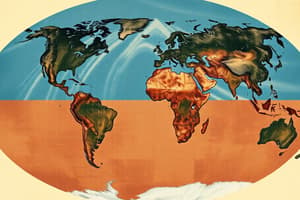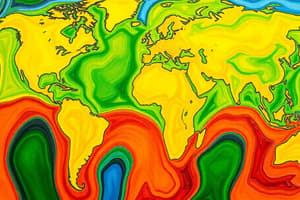Podcast
Questions and Answers
Who proposed the theory of continental drift?
Who proposed the theory of continental drift?
- Charles Lyell
- Alfred Wegener (correct)
- David Attenborough
- Isaac Newton
The term Pangaea means 'entire earth' in Greek.
The term Pangaea means 'entire earth' in Greek.
True (A)
What fossil evidence supports the theory of continental drift?
What fossil evidence supports the theory of continental drift?
Mesosaurus
Alfred Wegener outlined his theory in his work titled 'The Origin of __________ and Oceans.'
Alfred Wegener outlined his theory in his work titled 'The Origin of __________ and Oceans.'
Match the following pieces of evidence with their descriptions:
Match the following pieces of evidence with their descriptions:
What was a significant limitation of Wegener's theory when it was first proposed?
What was a significant limitation of Wegener's theory when it was first proposed?
Wegener's work was widely accepted during his lifetime.
Wegener's work was widely accepted during his lifetime.
What is one type of evidence Wegener used to support continental drift?
What is one type of evidence Wegener used to support continental drift?
Wegener died during an expedition to the __________.
Wegener died during an expedition to the __________.
Which of the following organisms was found in both South America and Africa providing evidence for continental drift?
Which of the following organisms was found in both South America and Africa providing evidence for continental drift?
Flashcards are hidden until you start studying
Study Notes
Theory of Continental Drift
- Continents appear to fit together like puzzle pieces, particularly the eastern coast of South America and western coast of Africa.
- Alfred Wegener, a German meteorologist in the early 20th century, proposed that continents were once connected in a supercontinent called Pangaea about 250 million years ago.
- The term Pangaea comes from Greek, meaning "entire earth."
Evidence for Continental Drift
-
Apparent Fit of Continents: The coastlines of continents resemble pieces of a puzzle, suggesting they were once joined.
-
Fossil Correlation: Identical fossils of species, such as Mesosaurus, found on separate continents (eastern South America and western Africa), indicate land connection at some point. Other organisms like Glossopteris also support this idea.
-
Rock and Mountain Correlation: Similar types and ages of rock found in mountain ranges across continents (e.g., northeastern United States and Northern Europe) suggest these landforms were once connected but have been separated by continental drift.
-
Paleo Climate Data:
- Glacial striations found in currently tropical regions (e.g., South America, Africa) suggest these areas were once positioned near the South Pole, indicating a colder past.
- Bituminous coal, formed from tropical plant materials, is found in cold regions like Antarctica and northern Europe, indicating these areas once had tropical climates.
Wegener’s Legacy
- Published "The Origin of Continents and Oceans" outlining his theory of continental drift with supporting evidence.
- Lacked an explanation for the mechanism behind continental movement, which limited early acceptance of his theory.
- Died during an expedition to the North Pole, never witnessing the acceptance of his work or understanding of continental movement. His body remains preserved in ice.
Theory of Continental Drift
- Continents can be visually matched like puzzle pieces, notably South America’s eastern coast with Africa’s western coast.
- Alfred Wegener introduced the concept of all continents merging into a supercontinent known as Pangaea around 250 million years ago.
- The term "Pangaea" derives from Greek, translating to "entire earth."
Evidence for Continental Drift
- Apparent Fit of Continents: Coastal configurations of continents strongly resemble a puzzle, suggesting prior connectivity.
- Fossil Correlation: Species' fossils, like Mesosaurus, identified on separate continents (eastern South America and western Africa) signify a historical land link; similar findings for organisms like Glossopteris bolster this evidence.
- Rock and Mountain Correlation: Consistent rock types and ages in mountain ranges across different continents (e.g., north-eastern United States and Northern Europe) imply these structures were once part of a continuous landmass.
- Paleo Climate Data:
- Presence of glacial striations in warm regions (South America, Africa) indicates a former polar location, pointing to a cooler historical climate.
- Bituminous coal, created from tropical vegetation, found in colder locales like Antarctica and northern Europe suggests these areas previously enjoyed a tropical climate.
Wegener’s Legacy
- Authored "The Origin of Continents and Oceans," detailing his continental drift theory and supporting observations.
- His inability to provide a viable explanation for the mechanics of continental movement hindered broader acceptance during his time.
- Wegener died during a North Pole expedition, not witnessing the eventual acceptance of his ideas on continental movement; his body remains frozen in ice.
Studying That Suits You
Use AI to generate personalized quizzes and flashcards to suit your learning preferences.




